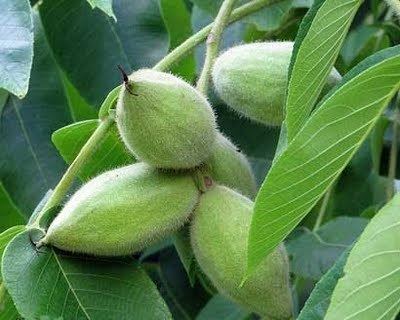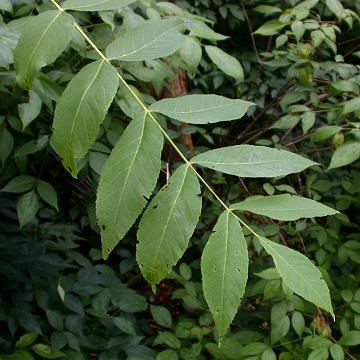Scientific name Juglans cinerea | Section Trachycaryon Rank Species | |
 | ||
Similar Hickory, Shellbark hickory, Pignut Hickory, Honey locust, Walnut | ||
Butternut aka white walnut juglans cinerea shade tree sweet tasting nuts seeds on www myseeds co
Juglans cinerea, commonly known as butternut or white walnut, is a species of walnut native to the eastern United States and southeast Canada.
Contents
- Butternut aka white walnut juglans cinerea shade tree sweet tasting nuts seeds on www myseeds co
- Distribution
- Description
- Flowering and fruiting
- Soil and topography
- Associated forest cover
- Canopy competition
- Butternut canker
- Hybrid resistance
- Other pests
- Conservation
- Lumber
- Fabric dye
- Medicinal
- References

Distribution

The distribution range of J. cinerea extends east to New Brunswick, and from southern Quebec west to Minnesota, south to northern Alabama and southwest to northern Arkansas. It is absent from most of the Southern United States. The species also proliferates at middle elevations (about 2,000 ft or 610 m above sea level) in the Columbia River basin, Pacific Northwest; as an off-site species. Trees with 7 ft or 2.1 m (over mature) class range diameter at breast height were noted in the Imnaha River drainage as late as January 26, 2015.
Description

J. cinerea is a deciduous tree growing to 20 m (66 ft) tall, rarely 40 m (130 ft). Butternut is a slow-growing species, and rarely lives longer than 75 years. It has a 40–80 cm (16–31 in) stem diameter, with light gray bark.

The leaves are pinnate, 40–70 cm (16–28 in) long, with 11–17 leaflets, each leaflet 5–10 cm (2–4 in) long and 3–5 cm (1 1⁄4–2 in) broad. The whole leaf is downy-pubescent, and a somewhat brighter, yellower green than many other tree leaves.
Flowering and fruiting
Butternut flowers from April to June, depending upon location, about the same time as the new leaves appear. The species is monoecious. Male (staminate) flowers are inconspicuous, yellow-green slender catkins that develop from auxiliary buds and female (pistillate) flowers are short terminal spikes on current year's shoots. Each female flower has a light pink stigma. Flowers of both sexes do not usually mature simultaneously on any individual tree.
The fruit is a lemon-shaped nut, produced in bunches of two to six together; the nut is oblong-ovoid, 3–6 cm (1 1⁄4–2 1⁄4 in) long and 2–4 cm (3⁄4–1 1⁄2 in) broad, surrounded by a green husk before maturity in midautumn.
Key characteristics:
Soil and topography
Butternut grows best on stream banks and on well-drained soils. It is seldom found on dry, compact, or infertile soils. It grows better than black walnut, however, on dry, rocky soils, especially those of limestone origin.
Butternut is found most frequently in coves, on stream benches and terraces, on slopes, in the talus of rock ledges, and on other sites with good drainage. It is found up to an elevation of 1,500 metres (4,900 ft) in the Virginias – much higher altitudes than black walnut.
Associated forest cover
Butternut is found with many other tree species in several hardwood types in the mixed mesophytic forest. It is an associated species in the following four northern and central forest cover types: sugar maple–basswood, yellow poplar–white oak–northern red oak, beech–sugar maple, and river birch–sycamore. Commonly associated trees include basswood (Tilia spp.), black cherry (Prunus serotina), beech (Fagus grandifolia), black walnut (Juglans nigra), elm (Ulmus spp.), hemlock (Tsuga canadensis), hickory (Carya spp.), oak (Quercus spp.), red maple (Acer rubrum), sugar maple (Acer saccharum), yellow poplar (Liriodendron tulipifera), white ash (Fraxinus americana), and yellow birch (Betula alleghaniensis). In the northeast part of its range, it is often found with sweet birch (Betula lenta) and in the northern part of its range it is occasionally found with white pine (Pinus strobus). Forest stands seldom contain more than an occasional butternut tree, although in local areas, it may be abundant. In the past, West Virginia, Wisconsin, Indiana, and Tennessee have been the leading producers of butternut timber.
Canopy competition
Although young trees may withstand competition from the side, butternut does not survive under shade from above. It must be in the overstory to thrive. Therefore, it is classed as intolerant of shade and competition.
Butternut canker
The most serious disease of J. cinerea is butternut decline or butternut canker. In the past, the causal organism of this disease was thought to be a fungus, Melanconis juglandis. Now this fungus has been associated with secondary infections and the primary causal organism of the disease has been identified as another species of fungus, Sirococcus clavigignenti-juglandacearum. The fungus is spread by wide-ranging vectors, so isolation of a tree offers no protection.
Symptoms of the disease include dying branches and stems. Initially, cankers develop on branches in the lower crown. Spores developing on these dying branches are spread by rainwater to tree stems. Stem cankers develop 1 to 3 years after branches die. Tree tops killed by stem-girdling cankers do not resprout. Diseased trees usually die within several years. Completely free-standing trees seem better able to withstand the fungus than those growing in dense stands or forest. In some areas, 90% of the butternut trees have been killed. The disease is reported to have eliminated butternut from North and South Carolina. The disease is also reported to be spreading rapidly in Wisconsin. By contrast, black walnut seems to be resistant to the disease.
Hybrid resistance
The hybrid between butternut and the Japanese walnut is commonly known as the 'buartnut' and shows resistance to the butternut canker. Researchers are back-crossing butternut to buartnut, creating 'butter-buarts" which should have more butternut traits than buartnuts. They are selecting for resistance to the butternut canker.
Other pests
Bunch disease also attacks butternut. Currently, the causal agent is thought to be a mycoplasma-like organism. Symptoms include a yellow witches' broom resulting from sprouting and growth of auxiliary buds that would normally remain dormant. Infected branches fail to become dormant in the fall and are killed by frost; highly susceptible trees may eventually be killed. Butternut seems to be more susceptible to this disease than black walnut.
The common grackle has been reported to destroy immature fruit and may be considered a butternut pest when populations are high.
Butternut is very susceptible to fire damage, and although the species is generally wind firm, it is subject to frequent storm damage.
Conservation
The species is not listed as threatened federally in the US, but is listed as "Special Concern" in Kentucky, "Exploitably Vulnerable" in New York State, and "Threatened" in Tennessee.
The Committee on the Status of Endangered Wildlife in Canada placed the butternut on the endangered species list in Canada in 2005.
Lumber
Butternut wood is light in weight and takes polish well, and is highly rot resistant, but is much softer than black walnut wood. Oiled, the grain of the wood usually shows much light. It is often used to make furniture, and is a favorite of woodcarvers.
Fabric dye
Butternut bark and nut rinds were once often used to dye cloth to colors between light yellow and dark brown. To produce the darker colors, the bark is boiled to concentrate the color. This appears to never have been used as a commercial dye, but rather was used to color homespun cloth.
In the mid-19th century, inhabitants of areas such as southern Illinois and southern Indiana – many of whom had moved there from the Southern United States – were known as "butternuts" from the butternut-dyed homespun cloth that some of them wore. Later, during the American Civil War, the term "butternut" was sometimes applied to Confederate soldiers. Some Confederate uniforms apparently faded from gray to a tan or light brown. It is also possible that butternut was used to color the cloth worn by a small number of Confederate soldiers. The resemblance of these uniforms to butternut-dyed clothing, and the association of butternut dye with home-made clothing, resulted in this derisive nickname.
Medicinal
Butternut bark has mild cathartic properties and was once used medicinally in place of jalap, a more expensive cathartic which was imported from Mexico.
During the American Revolution, a butternut extract made from the inner bark of the tree was used in an attempt to prevent smallpox, and to treat dysentery and other stomach and intestinal discomfort.
